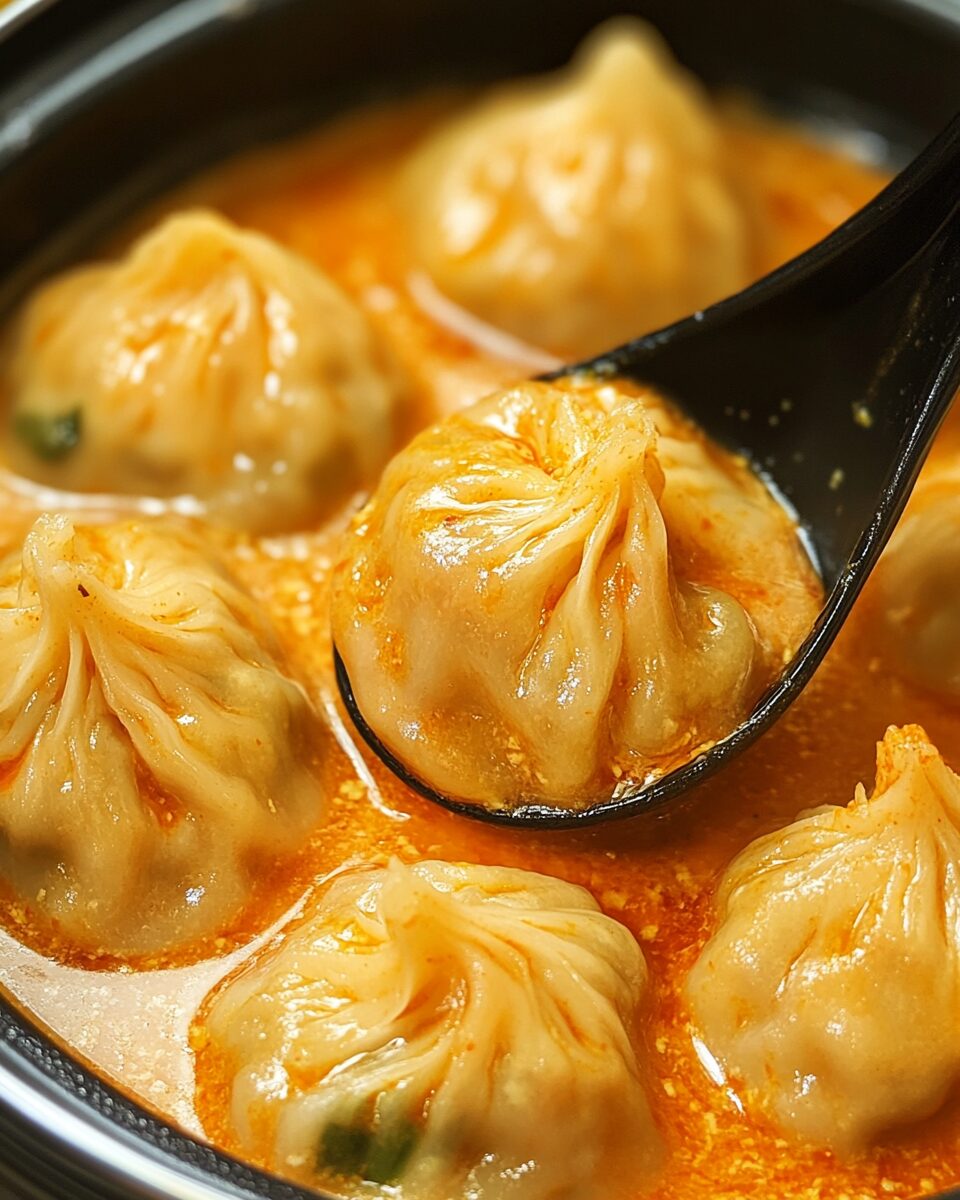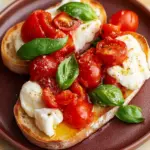The fusion of spicy Korean gochujang and the indulgent creaminess of Italian vodka sauce meets juicy, savory soup dumplings in this truly comforting dish. Each bite delivers warmth, depth, and layers of umami flavor that will leave you craving more.
Perfect for a cozy night in or an exciting new twist on your weekly dinner rotation, this dish is as easy to prepare as it is impressive. It’s a simple one-pot wonder that brings out bold flavors without complicated steps – truly a celebration of cultural creativity on a plate.
Full recipe:
Ingredients:
-
8-10 frozen soup dumplings
-
1 tbsp unsalted butter
-
2 cloves garlic, minced
-
1 tbsp gochujang
-
1 cup heavy cream
-
½ cup water
-
Salt, to taste
-
Pepper, to taste
-
Parmesan Reggiano cheese, grated
-
Chopped chives or sage, for garnish (optional)
Directions:
-
In a medium pot, melt the butter over medium-high heat.
-
Add the minced garlic and sauté for 1–2 minutes, until fragrant.
-
Stir in the gochujang, heavy cream, and water. Mix until smooth and bring to a gentle simmer.
-
Carefully add the frozen soup dumplings into the sauce, ensuring they don’t touch.
-
Cover the pot and steam for 12 minutes, or until dumplings are fully cooked.
-
Turn off the heat and sprinkle freshly grated Parmesan over the dumplings.
-
Garnish with chopped chives or sage before serving.
Prep Time: 5 minutes | Cooking Time: 12 minutes | Total Time: 17 minutes
Kcal: 360 kcal | Servings: 2 servings
What Makes Gochujang So Special?
At the heart of this dish lies gochujang, a fermented Korean chili paste known for its deep umami profile, balanced spiciness, and hint of sweetness. It’s made from gochugaru (Korean red pepper flakes), fermented soybeans, glutinous rice, and salt—ingredients that ferment together to create something uniquely pungent, complex, and completely addictive.
Gochujang is not just spicy; it adds depth and body to any dish it graces. Traditionally used in dishes like tteokbokki (spicy rice cakes), bibimbap (mixed rice bowls), and budae jjigae (army stew), gochujang has gained popularity in global kitchens for its versatility. In this particular recipe, it plays a starring role in transforming a Western-style cream sauce into something much more vibrant and layered.
Why Dumplings?
Soup dumplings, also known as xiao long bao, bring their own kind of magic. Originating from Chinese cuisine, they’re delicate steamed dumplings that are filled not just with meat but also a rich, gelatinous broth that turns to liquid during cooking. Each dumpling is like a tiny, savory flavor bomb.
When these dumplings are nestled in a creamy, spicy sauce, the texture contrast is extraordinary. The dumpling skin remains soft and chewy, the filling stays juicy, and the surrounding sauce becomes an extension of the bite—coating each dumpling in layers of creamy heat and savory bliss.
The use of frozen dumplings in this recipe makes it even more accessible for home cooks, and yet the end result tastes gourmet. That’s part of the dish’s genius—you get complexity without complication.
The Inspiration Behind the Sauce
This dish is inspired by Italian vodka sauce, a creamy tomato-based pasta sauce known for its luscious texture and mild heat. The twist here is the substitution of tomato and vodka with gochujang and a more pronounced dairy presence through heavy cream and Parmesan cheese.
The result? A gochujang cream sauce that’s smooth, rich, spicy, and utterly addictive. The fermentation in gochujang adds umami and funk, while the cream mellows out the heat and enhances the luxurious mouthfeel. Parmesan cheese contributes a salty, nutty sharpness that rounds out the sauce’s profile beautifully.
Cultural Harmony in Every Bite
What makes this dish stand out isn’t just its boldness, but the harmony it achieves. It’s a perfect example of culinary balance—spicy but not overpowering, creamy but not too heavy, rich but still refreshing thanks to the slight tang and heat from the gochujang.
It’s also a statement about cultural respect. Instead of randomly throwing ingredients together, this dish thoughtfully blends elements from Korean and Italian cuisines. It maintains the integrity of both traditions while forming something original. It honors Korean flavors through the gochujang and Chinese cuisine through the dumplings, while borrowing Italian techniques to create a creamy, cohesive sauce. This respect is essential in successful fusion cooking.
Flavor Profiles and Pairings
Let’s talk about flavor. Imagine biting into a dumpling and being met with a wave of savory soup inside. That’s quickly followed by a swirl of buttery cream spiked with chili heat and garlic, then finished with nutty Parmesan and aromatic herbs like chives or sage.
It’s warm and spicy, yet soft and silky. It’s layered and indulgent, yet somehow comforting. This dish hits all the right notes for a satisfying weeknight dinner or an elevated comfort food for a dinner party.
As for pairings, consider serving this dish with:
-
A crisp, light white wine like Sauvignon Blanc or Pinot Grigio to balance the richness
-
Steamed rice or rice cakes on the side to soak up any extra sauce
-
A simple cucumber salad to provide a refreshing contrast
-
Lightly sautéed greens or pickled vegetables to cut through the creaminess
Time-Saving Yet Impressive
One of the best things about this dish is that it’s quick and easy to prepare, yet incredibly impressive in both taste and appearance. By using pre-made frozen dumplings, you cut down prep time significantly while still delivering a dish that tastes like it came from a high-end fusion restaurant.
In under 20 minutes, you can put together a dish that’s rich, flavorful, and absolutely Instagram-worthy. It’s perfect for busy weeknights when you crave something warm and satisfying, but it also doubles as a showstopper for hosting friends or loved ones.
Customizable and Adaptable
This dish is also highly customizable. Want more vegetables? Toss in some sautéed mushrooms or baby spinach into the sauce. Prefer it vegetarian? Use veggie dumplings and substitute Parmesan with a plant-based cheese. You can even tweak the heat level by adjusting the amount of gochujang or balancing it with a bit more cream.
Additionally, you can add texture by topping the dish with toasted sesame seeds or crushed peanuts. For a fresher finish, a squeeze of lime juice or a sprinkle of microgreens can elevate it even more.
Fusion cooking encourages this kind of experimentation. The rules are more flexible, as long as the flavors are balanced and the ingredients are treated with care.
The Visual Appeal
From a presentation standpoint, this dish is a stunner. The warm orange-red hue of the gochujang cream sauce looks bold and inviting against the pale dumplings. The melted Parmesan on top adds a bit of rustic charm, while the fresh herbs make the dish pop visually.
If you’re creating content for social media, you’ll love how photogenic this meal is. A drizzle of extra cream or olive oil, a few red chili flakes, and a sprinkle of chives are all it takes to elevate the look of this already eye-catching dish.
A Gateway to Global Cooking
For many home cooks, fusion dishes like this one serve as a gateway to trying new ingredients and cultural cuisines. You might discover gochujang for the first time, then suddenly find yourself adding it to eggs, marinades, or even salad dressings. You may also get curious about traditional dumpling-making or explore more fermented Korean staples like doenjang (fermented soybean paste) or kimchi.
Cooking, after all, is one of the best ways to explore the world without leaving your kitchen. This dish exemplifies that journey beautifully—taking you from Seoul to Shanghai to Rome and back again in just a few bites.
Conclusion: Why You Should Try This Dish
Soup Dumplings in Creamy Gochujang Sauce is more than just a trendy fusion dish—it’s a celebration of flavor, culture, and creativity. It brings together the comforting, soul-warming elements of Korean, Chinese, and Italian cuisine in a way that feels both familiar and fresh.
Whether you’re a foodie looking for your next obsession, a busy cook who wants flavor without fuss, or a home chef who loves to explore new culinary frontiers, this dish is for you. It’s easy to make, deeply satisfying, and endlessly customizable. Most importantly, it’s a perfect reminder that great food knows no borders—it just knows how to make people happy.






